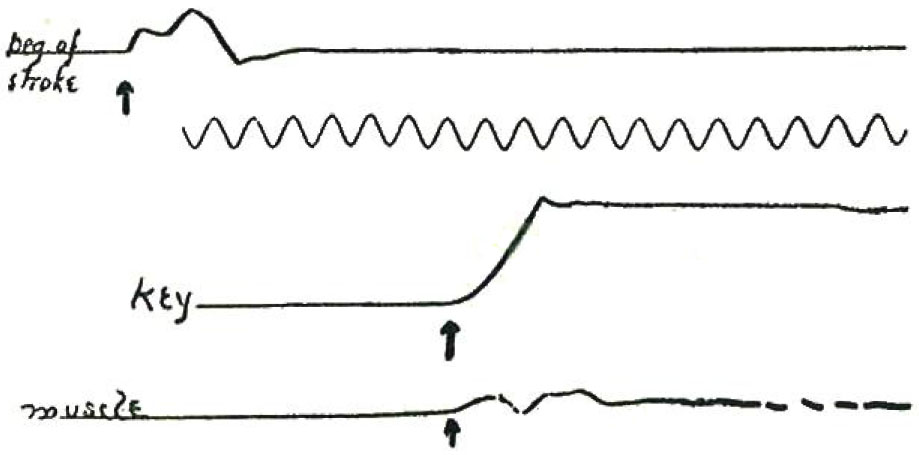Time Relationship
The "economy of energy" characteristic of all coordinated movements demands also that the agogic[1] sequence of the parts of the movement, the time-relationship, among the various phases of the movement, be those of least waste of effort. Among other things this means that the contraction of a muscle should not continue after the work of the original contraction has been done.
In piano playing, sustained contraction has at times a physiological value, but no mechanical or tonal advantage (since once the tone has been produced, it cannot be altered). On string instruments, such as the violin, sustained contraction plays a more important role.
Most movements of piano technique are semi-rapid contractions followed by periods of relaxation.
The ratio between the time of contraction and the time of relaxation is one measure of coordinated movement.In fact , I am inclined to believe that the readiness with which relaxation sets in between movements, whether they are movements of 1) fingers, 2) hand or 3) arm, is a fair index of kinesthetic[2] talent as applied to the piano.
Short Muscular Contration
At any rate I have always found, in watching the playing of technically talented, though pianistically untrained students, that a nicely adjusted relaxation is always present immediately after tone-production. The opposite of this is an accepted fact: The sustained contraction (useless stiffness) of untalented pupils is pianistically undesirable. But the relaxation following tone-production has frequently, but erroneously, been supposed to exist during tone-product ion as well, and has given rise to a pedagogy of tone-production that robs the player's style of much force, velocity, and brilliance. A coordinat ed movement, considered in its time phase, is one in which the muscular contraction is of as short duration as possible in view of the desired effect .

In Figure 40 is shown an example of a well-coordinated movement at the beginning of the stroke the muscles opposing key-resistance (in this case the flexor carpi radialis[3]) are not contracted until the key-resistance is met. The descent of the arm to key-level was done

with a relaxed hand. The latter became fixed just before key contact, in order to meet the key-resistance effectively.
Compare two types of Contraction
Compare this with the two records of Fig. 41.
These represent in-coordinated movements, as made by two untalented pupils.
In the first record, muscular contraction took place but it was opposed by simultaneous contraction of the antagonists . As a result, the original flexor contraction went to non-existent, since the key was not depressed at all. The key-surface was just about touched, hence the small break in the key-line at the arrow.
At b) in Fig. 41, the muscle contracts long in advance of the key contact, and remains contracted well after key-release. All of this 1) premature contraction and 2) post-prolongation represent wasted effort, not only producing no useful effect, but also seriously restricting other phases of movement.
In the first record, muscular contraction took place but it was opposed by simultaneous contraction of the antagonists . As a result, the original flexor contraction went to non-existent, since the key was not depressed at all. The key-surface was just about touched, hence the small break in the key-line at the arrow.
At b) in Fig. 41, the muscle contracts long in advance of the key contact, and remains contracted well after key-release. All of this 1) premature contraction and 2) post-prolongation represent wasted effort, not only producing no useful effect, but also seriously restricting other phases of movement.
This time-relationship of a coordinated movement may therefore be stated as follows :
The contraction of a muscle should take place a moment before, or upon the introduction of the resistance which the muscle has to overcome. The muscular contraction should cease after the resistance has been overcome.
[1]agogic: relating to or denoting an accent produced by lengthening the time value of a note.
[2]kinesthetic:relating to a person's awareness of the position and movement of the parts of the body by means of sensory organs (proprioceptors) in the muscles and joints.
[3]flexor carpi radialis:The flexor carpi radialis muscle is a long, superficial muscle of the forearm that belongs to the anterior muscle group and lies in the first layer. It is a relatively thin muscle located on the anterior part of the forearm.